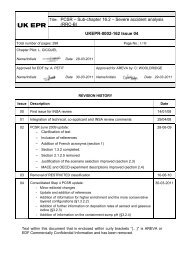14.7 - Fault and Protection Schedule - EDF Hinkley Point
14.7 - Fault and Protection Schedule - EDF Hinkley Point
14.7 - Fault and Protection Schedule - EDF Hinkley Point
You also want an ePaper? Increase the reach of your titles
YUMPU automatically turns print PDFs into web optimized ePapers that Google loves.
PRE-CONSTRUCTION SAFETY REPORT<br />
CHAPTER 14: DESIGN BASIS ANALYSIS<br />
SUB-CHAPTER : <strong>14.7</strong><br />
PAGE : 13 / 48<br />
Document ID.No.<br />
UKEPR-0002-149 Issue 02<br />
3.4. SET OF I&C FUNCTIONS<br />
3.4.1. NUSO functions<br />
When two I&C functions, with the same classification, perform opposing actions within the same<br />
safety system, the one which has priority over the other one is called Non-unequivocally Safety<br />
Oriented (NUSO). All other I&C functions are called Unequivocally Safety Oriented (USO).<br />
The faulty actuation of NUSO, during many events, significantly lessens or impairs the actual<br />
plant safety level, because it prevents from the action of an other I&C function which is needed<br />
to mitigate the accident.<br />
Due to their potential negative impact on safety when spuriously actuated, the NUSO I&C<br />
functions shall be designed in a way to minimise the probability of spurious action.<br />
3.4.2. Setpoints scales<br />
Setpoints result from the hierarchical organisation of I&C functions described above.<br />
The overall I&C design approach to ensure a high level of plant safety is based on:<br />
• consideration of the channel accuracy,<br />
• consideration of the response time of the I&C function,<br />
• the threshold margin to ensure plant reliability in case of failure of the dedicated I&C<br />
function,<br />
• application of the single failure criterion to I&C systems,<br />
• priority requirements between different I&C functions.<br />
In Sub-chapter <strong>14.7</strong> - Figures 1 <strong>and</strong> 2, examples of setpoint scales with the corresponding<br />
actions are shown.<br />
3.5. RESET OF AUTOMATIC PROTECTION FUNCTIONS<br />
3.5.1. Definition<br />
A reset is an operator action to clear the memory of a stored automatic signal. It may be<br />
necessary to inhibit an automatic signal to cancel actions initiated by the signal. In most cases, a<br />
reset does not imply any automatic action but only allows a manual control of the system. When<br />
actuators receive comm<strong>and</strong>s from the protection system, these comm<strong>and</strong>s have priority over<br />
manual actions. In this case, the reset of the protection system comm<strong>and</strong> is necessary to allow<br />
manual operation of the actuators in the control room in a post-accident situation on the safe<br />
path.<br />
Note<br />
As mentioned above, in general there is priority of automatic comm<strong>and</strong>s generated in PS<br />
over manual comm<strong>and</strong>s performed by the operator.














![6.3 - Safety Injection System (RIS [SIS]) - EDF Hinkley Point](https://img.yumpu.com/42739985/1/184x260/63-safety-injection-system-ris-sis-edf-hinkley-point.jpg?quality=85)


